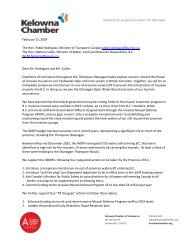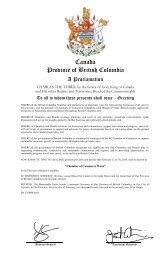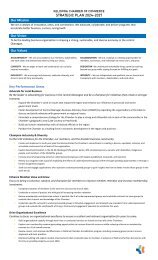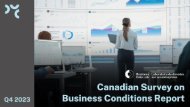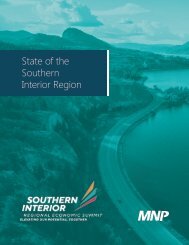Chamber_ResourceGuide_ThompsonOkanagan_August9_2021
You also want an ePaper? Increase the reach of your titles
YUMPU automatically turns print PDFs into web optimized ePapers that Google loves.
pg
SECTION 05 | LOOKING FORWARD
The 7 myths include:
The 7 myths
standing between
you and a hybrid
future of work
1 - Our existing remote work strategy will work for a hybrid
workforce – existing workforce strategies assume that remote work will
continue to be an exception and that things will return to ‘normal’ once the
pandemic subsides. The new reality is that hybrid models are driven by
adaptability and interchangeability – choices will flex according to the details
and context of the work.
2 - Workers are less productive outside the office – in the pre-
COVID-19 environment, remote work was limited. Gartner dispels this myth by
saying “The question is no longer whether workers can be productive when
working remotely. The question is what you need to provide to workers for
them to be productive.”
3 - We need to monitor and measure what workers are doing –
productivity is extremely difficult to quantify. When given a choice of where,
when and how much they work, workers actually thrive.
4 - Our jobs just can’t be done remotely – this myth prevails because
many executives tend to look at jobs as a whole rather than looking at the
tasks that make up the job. In reality, most jobs fall somewhere on a spectrum
between fully portable and fully nonportable.
5 - We need in-person contact to sustain our culture – the myth that
workplace culture is ‘constant’ is at the root of this problem. In truth, agility and
trust define culture and don’t relate to physical location.
6 - Hybrid workforce models hurt diversity, equity and inclusion
strategy (DEI) – this myth is driven by the concern that physically separating
workers will undermine diversity, equity and inclusion. Gartner suggests that
removing unconscious bias in talent management will dramatically enhance
diversity regardless of where the work is being performed.
7 - A hybrid workforce model duplicates our IT infrastructure –
Gartner maintains that resilient organizations continuously reengineer their
IT strategies and infrastructure anyway and that “Everywhere Enterprise”
strategies use technology, team structures, processes, skills and tools to
empower dispersed workforces.
ANTICIPATING RISKS
It is absolutely clear that businesses in the Thompson | Okanagan Region will
face uncertainty in the wake of COVID-19. Typically, businesses respond to
uncertainty in one of two ways – first, acknowledge it and become paralyzed by it.
This translates to a slow or erratic response. The second common approach is to
face the challenge quickly or superficially or even over-confidently – without fully
considering the outcome. Consider the video rental business where complacency
in the face of technological advances left many companies flat-footed and unable
to pivot to new approaches.
BCBusiness has posted a risk management guide for business.
DOWNLOAD
BUSINESS CONTINUITY
CHECKLIST
KPMG offers a different perspective on future challenges. Their website presents a
list of risks. Check out the brief explanations of these 19 risks along with measures
to consider in order to mitigate those risks. From fraud to virtual workplace to
political instability – the list is comprehensive.
30
A THOMPSON | OKANAGAN RESOURCE GUIDE FOR SMALL BUSINESS RESILIENCY | Copyright © 2021 – BC Chamber of Commerce



